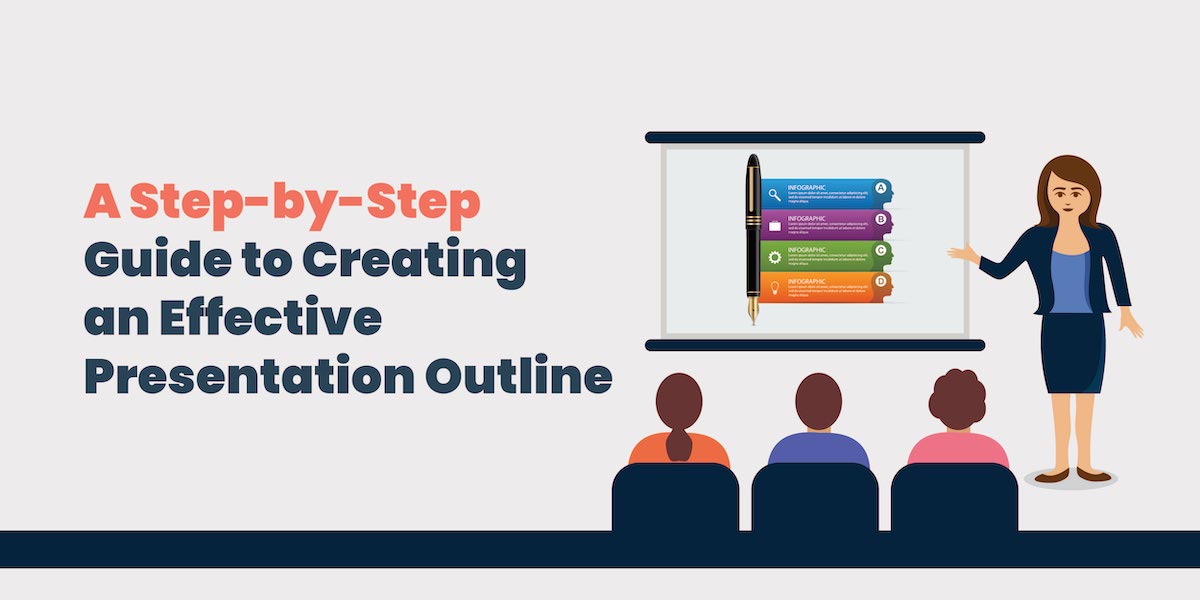Whether you are solving a puzzle, cooking a meal, or writing an article – the tasks can be significantly easier if all the pieces are present before you start. A presentation outline is a tool that will help a presenter arrange the ideas and make the conversation flow logically to give an efficient and effective presentation.
It may feel like wasting time planning the presentation when you could get started directly. But the facts and experience of great presenters in history give premises for the opposite. Planning saves time, and the same applies to business presentations or writing a speech. Start with planning; start with the presentation outline.
In this article, we’re going to understand the presentation outline, discuss its significance, provide a step-by-step guide on how to create one, and provide some expert advice.
What is a Presentation Outline?
A presentation outline is a simplified summary of your speech. Its purpose is to help you shape your thinking, make your presentation presented in the most logical manner, and organize the material in the most efficient way. It should follow the basic structure of your presentation and include concise summaries of your major points.
Why create a Presentation Outline?
A presentation outline can guide you in preparing for your presentation or speech. It provides you with a simplified version of the synopsis of your thoughts and a direct route for moving your audience from where they are now to where you desire them to be. Some of the key advantages of the presentation outline are:
· Helps the speaker review the content’s scope and check the applicability of supportive arguments
· Helps organize a message that the audience can understand by creating a visual aid showing the balance and proportion of a speech
· Saves time by helping you brainstorm the presentation
· Assisting with what ideas to keep in the presentation
· Gives general direction to your presentation
How to Create a Presentation Outline
“A person without a plan is lost before they start.” – Lewis K Bendele
Here is a step-by-step guide to creating the outline for your presentation:
1. Know the Purpose of Your Presentation
The essential part of creating a presentation outline is to determine the goal of your presentation. To find this, consider what you want your audience to learn or support following your talk. For example, a non-profit organization that takes care of street dogs may give a presentation to persuade listeners to take care of street dogs by giving them some food. The goal for the presentation should be very concise and measurable so you can have a particular point of focus for your presentation. The most common goals for presentations include:
· Motivating
· Educating
· Inciting an action
· Informing
· Entertaining
· Persuading users to do something specific
2. Build a Structure
To build a great skyscraper, make sure the structure is right! The same goes for building an efficient presentation outline. While building the structure of your presentation outline, consider in which direction each of your discussion points is going in your talk and what premises you can use to support those points. The most popular way to organize the structure is by writing each point on sticky notes so that they can move around and see how each point contributes to the purpose of the presentation. To make better use of the audience’s time, you can also write how much time each segment of the presentation takes. The three major segments into which a presentation is divided are:
· Introduction
· Body
· Conclusion
3. Outline the Start of Your Presentation
Have you wondered why great presenters always start their presentations with a rhetorical question, or share a relatable story, or use a quote? The answer to this is they create a backstage for their presentation and engage their audience early on by setting the tone they want for the rest of their presentation. These are the ways they grab the attention of the audience, which leads to better engagement and response.
When you plan your presentation outline, always plan how you want to start the presentation, as it will set the tone and backstage of your presentation.
4. Use Visual Aids
We’ve all been there; those long lectures and corporate meetings, where you give it all to stay attentive to the data being shown and slowly being read off of a boring spreadsheet.
Don’t make that same mistake in your presentation. Incorporate your data in a visual and engaging way. Take a thought about adding pictures, videos, or other content to your presentation. The style and color scheme you choose for the text on your slides should be taken into account as additional visual material. You can communicate some emotions through color; for example, the color red portrays passion.
While outlining your presentation, mention which visual aids you want to use, where, and how you want to use them.
5. Include a Call-to-Action
Add a call-to-action for your audience to get a better outcome from your presentation. For example, a businessman in a presentation to the audience will try to persuade them to buy his company’s product. Call-to-action brings the audience to the desired place that you want them to. Make your audience aware of the benefits they will get by coming to your desired place.
Clearly mention in your presentation outline which CTA you will be using.
Conclusion
A presentation outline is a tool that can be used for creating a presentation in the most logical manner. It helps improve the presentation on an all-rounder basis. Moreover, it gives your audience a visual representation of what you will be talking about and supports in capturing their interest.
It takes meticulous planning, close attention to content details, and a keen eye for design to produce an effective presentation outline. If not properly outlined, even the best presentations can be disastrous.
“Practice makes a man perfect,” as they said.
“Practice can make your presentation perfect,” we implied.
